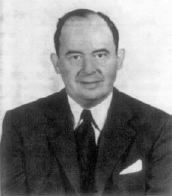

As a child, John von Neumann showed he had an incredible memory.
At the age of 6, he was able to exchange jokes with his father in classical Greek. The Neumann family sometimes entertained guests with demonstrations of his ability to memorize phone books. In 1911, von Neumann entered the Lutheran Gymnasium, where he would study for 10 years. His mathematics teachers quickly recognised von Neumann's genius.
His first mathematics paper, written jointly with his tutor, was published in 1922. While he studied mathematics in Budapest, he studied chemistry in Berlin and Zürich, and received a degree in chemical engineering in 1926. While in Zürich, he continued his interest in mathematics, and interacted with Weyl and Pólya.
Von Neumann received his doctorate in mathematics from the University of Budapest, also in 1926, with a thesis on set theory. He published a definition, the one used today, of
ordinal numbers when he was 20.
Von Neumann lectured at Berlin for three years and at Hamburg for one year. However he also held a fellowship to enable him to
undertake postdoctoral studies at the University of Göttingen, where he studied under Hilbert. By this time von Neumann had achieved celebrity status.
From 1930 and 1933 von Neumann taught at Princeton University, but this was not one of his strong points. He was notorious for dashing out equations on a small portion of the
available blackboard and erasing expressions before students could copy them.
He became one of the original 6 mathematics professors in 1933 at the newly founded Institute for Advanced Study in Princeton, a position he kept for the remainder of his life.
He became co-editor of the Annals of Mathematics and Compositio Mathematica, and held these editorships until his death.
His published a text which built a solid framework for the new quantum mechanics.
He introduced the idea of a self-adjoint algebra of bounded linear operators on a Hilbert space, now referred to as von Neumann algebras.
In game theory, von Neumann proved the minimax theorem. He gradually expanded his work in game theory, and with co-author Oskar Morgenstern, he
wrote the classic text Theory of Games and Economic Behaviour.
In 1938 the American Mathematical Society awarded him the Bôcher Prize for his memoir Almost periodic functions and groups.
Around this time von Neumann turned to applied mathematics. He was fascinated by the problem of hydrodynamical turbulence.
Von Neumann was one of the pioneers of computer science, making significant contributions to the development of logical design. He spent a considerable part of the last few years of his life working in automata theory. Involving a mixture of pure and applied mathematics as well as other sciences, automata theory was an ideal field for von Neumann's wide-ranging intellect.
He advanced the theory of cellular automata, advocated the adoption of the bit as a measurement of computer memory, and solved problems in obtaining
reliable answers from unreliable computer components.
During and after World War II, von Neumann served as a consultant to the armed forces. His valuable contributions included a proposal of the implosion
method for bringing nuclear fuel to explosion and his participation in the development of the hydrogen bomb.
It would be almost impossible to give even an idea of the range of honours which were given to von Neumann. He was elected to many learned academies. He received two Presidential Awards, the Medal for Merit in 1947, and the Medal for Freedom in 1956. Also in 1956, he received the Albert Einstein Commemorative Award and the Enrico Fermi Award.